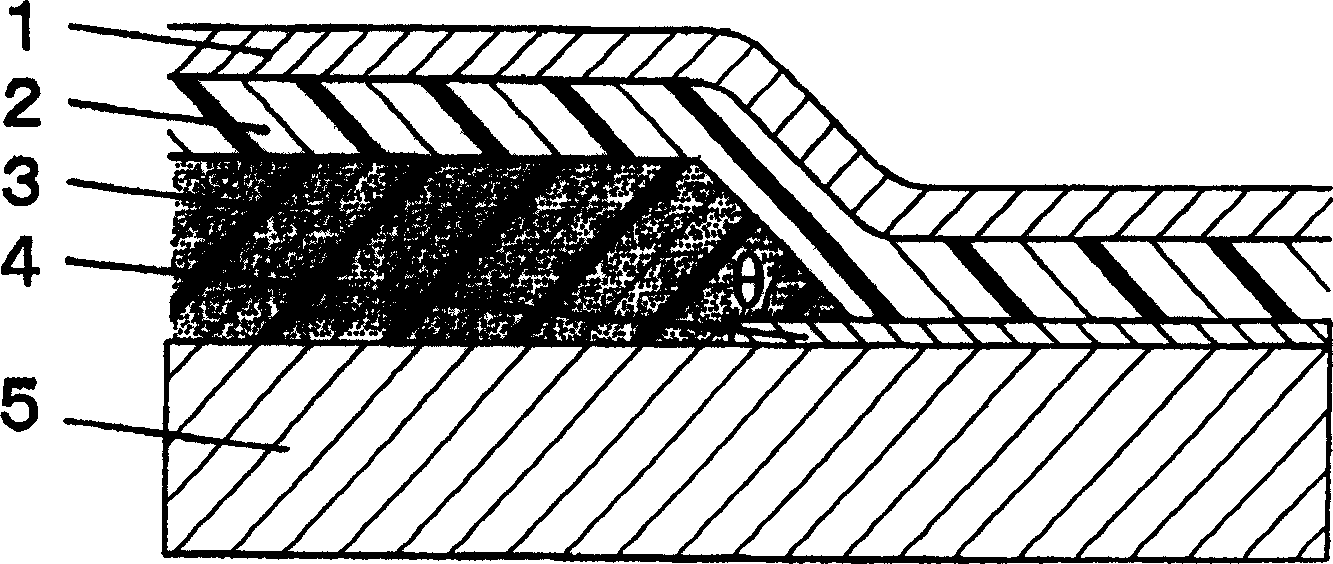Positive photosensitive resin composition
A technology of photosensitive resin and composition, applied in optics, optomechanical equipment, instruments, etc., can solve problems such as heat resistance, difficulty in continuous use of display devices, inability to obtain light-shielding properties, etc.
- Summary
- Abstract
- Description
- Claims
- Application Information
AI Technical Summary
Problems solved by technology
Method used
Image
Examples
Embodiment 1
[0162] In 264g of methyl isobutyl ketone, dissolve 57g (0.6mol) of m-cresol, 38g (0.4mol) of p-cresol, 75.5g (formaldehyde 0.93mol) 37wt% formaldehyde solution and 0.63g (0.005mol) ) of oxalic dianhydride, carried out polycondensation reaction under reflux and stirring state for 4 hours. The product was heated for 3 hours, then the pressure in the flask was reduced to 4000-6666 Pa to remove volatiles. The molten resin was recovered after cooling the mixture to room temperature. The resulting resin was dissolved in ethyl acetate to obtain a resin component concentration of 30% by weight. To this solution, methanol in an amount 1.3 times the weight of the solution and water in an amount 0.9 times the weight of the solution were added, and the resulting mixture was stirred. After the mixture was separated into two layers, the lower layer was recovered, concentrated and dried to obtain a novolac resin.
[0163] To 100 parts by weight of the novolac resin thus obtained, add: 30 ...
Embodiment 2
[0170] In 250 ml of propylene glycol monomethyl ether, 176 g (0.1 mol) of t-butoxystyrene and 5.8 g (0.04 mol) of azobisisobutyronitrile were dissolved, and the mixture was reacted at 75° C. for 4 hours. To the obtained poly-tert-butoxystyrene solution was added 50 g of a 5 wt % sulfuric acid aqueous solution, and a hydrolysis reaction was performed at 100° C. for 3 hours. The reaction product was washed three times with 1000 ml of deionized water, and 500 ml of propylene glycol monomethyl ether acetate was added thereto to exchange the solvent, thereby obtaining an alkali-soluble resin (polyhydroxystyrene) solution.
[0171] The alkali-soluble resin solution thus obtained (corresponding to 100 parts by weight (solid content) of polyhydroxystyrene) is mixed with the following: 30 parts by weight of the diazo compound (H) of quinone, 25 parts by weight of 4,4' , 4 ", 4'-(1,4-phenylene dimethylidene) tetraphenol (absorption maximum: 440nm), 30 parts by weight of Pigment Blue 60 ...
Embodiment 3
[0174] To a solution of 7 parts by weight of 2,2'-azo (2,4-dimethylvaleronitrile) in 200 parts by weight of propylene glycol monomethyl ether acetate, add 10 parts by weight of styrene, 20 parts by weight of Methacrylic acid, 45 parts by weight of glycidyl methacrylate, and 25 parts by weight of dicyclopentanyl methacrylate were mixed slowly after replacing the atmosphere with nitrogen. The solution was kept at the same temperature for 5 hours to obtain an acrylic resin solution.
[0175]The acrylic resin solution thus obtained (corresponding to 100 parts by weight (solid content) of the acrylic resin) was mixed with the following: 25 parts by weight of the diazo compound (G) of the quinone, 25 parts by weight of 4,4 as the thermosensitive compound ', 4 "-methylidene triphenol (absorption maximum: 460nm), 25 parts by weight of Pigment Blue 15:6 (phthalocyanine blue E, absorption maximum: 670nm) and 15 parts by weight of Pigment Blue 60 (indigo, absorption Maximum: 570 nm, 720...
PUM
| Property | Measurement | Unit |
|---|---|---|
| thickness | aaaaa | aaaaa |
| thickness | aaaaa | aaaaa |
| optical density | aaaaa | aaaaa |
Abstract
Description
Claims
Application Information
 Login to View More
Login to View More - R&D
- Intellectual Property
- Life Sciences
- Materials
- Tech Scout
- Unparalleled Data Quality
- Higher Quality Content
- 60% Fewer Hallucinations
Browse by: Latest US Patents, China's latest patents, Technical Efficacy Thesaurus, Application Domain, Technology Topic, Popular Technical Reports.
© 2025 PatSnap. All rights reserved.Legal|Privacy policy|Modern Slavery Act Transparency Statement|Sitemap|About US| Contact US: help@patsnap.com



